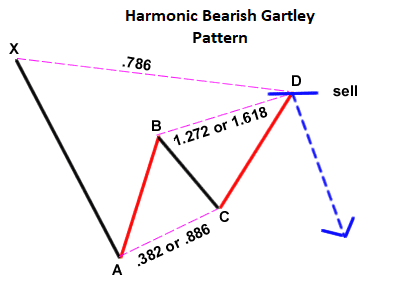Forex trading strategies for using the Harmonic Bearish Gartley pattern: Techniques for trading with the Harmonic Bearish Gartley pattern.
In the ever-evolving world of forex trading, where strategies and patterns play a crucial role in achieving success, the Harmonic Bearish Gartley pattern stands as a powerful tool in a trader's arsenal. This unique pattern combines geometric price patterns with Fibonacci retracement and extension levels to identify potential trend reversals. In this article, we will delve into the depths of the Harmonic Bearish Gartley pattern, explore its components, and outline effective trading techniques to capitalize on its potential.
Table Content
I. Understanding the Harmonic Bearish Gartley Pattern: A Primer
II. Trading Techniques for the Harmonic Bearish Gartley Pattern
1. Pattern Recognition and Entry Points
2. Confluence of Fibonacci Levels
3. Use of Oscillators and Momentum Indicators
4. Risk Management and Position Sizing
5. Practice Patience and Discipline
6. Back testing and Demo Trading
7. Combine with Other Strategies
8. Continuous Learning and Adaptation
III. Footnote
Understanding the Harmonic Bearish Gartley Pattern: A Primer
The Harmonic Bearish Gartley pattern is a subset of the larger family of harmonic patterns, which seeks to identify potential reversal points within the forex market. This pattern is particularly useful for traders looking to identify when an uptrend might reverse and transform into a downtrend. It's named after H.M. Gartley, who introduced it in his 1935 book "Profits in the Stock Market."

The pattern is characterized by a distinct shape that resembles the letter "M" or "W" on price charts. The Bearish Gartley pattern comprises four main price swings, labeled XA, AB, BC, and CD. These swings are defined by Fibonacci retracement and extension levels, providing traders with a structural framework to anticipate potential turning points.
- X to A Leg: This is the initial swing where the pattern begins. It represents the first leg of the potential reversal. Traders look for an identifiable move against the prevailing trend.
- A to B Leg: The second leg retraces a portion of the XA leg. It typically retraces around 61.8% of the XA leg's distance. This retracement often corresponds with the 0.786 Fibonacci retracement level.
- B to C Leg: The BC leg continues the retracement, usually stopping at the 38.2% retracement level of the AB leg. This leg also marks the completion of the potential reversal zone.
- C to D Leg: The final CD leg extends beyond the XA leg, typically covering around 127.2% to 161.8% of the XA leg's range. This leg confirms the pattern's completion and suggests the potential for a trend reversal.
Trading Techniques for the Harmonic Bearish Gartley Pattern
While recognizing the Harmonic Bearish Gartley pattern is essential, successful trading hinges on deploying effective strategies that complement the pattern's dynamics. Here are some techniques to consider when trading this pattern:
1. Pattern Recognition and Entry Points
Identifying the pattern accurately is the first step. Utilize charting software that highlights harmonic patterns or practice manual identification to spot the distinct M/W shape. Entry points are typically established at the D point, which is the termination of the CD leg. This is where traders anticipate the reversal to initiate.
2. Confluence of Fibonacci Levels
Fibonacci retracement and extension levels are crucial components of the pattern. However, combining these levels with other technical indicators can enhance the accuracy of your trades. Look for confluences between the pattern's key levels and other support and resistance levels, moving averages, or trendlines. The more factors that align at the D point, the stronger the potential reversal signal.
3. Use of Oscillators and Momentum Indicators
To confirm the potential reversal, traders often use oscillators and momentum indicators. These tools help gauge the strength of the anticipated reversal. Oversold conditions in indicators like the Relative Strength Index (RSI) can serve as confirmation that the market sentiment is shifting in favor of the bearish reversal.
4. Risk Management and Position Sizing
Like any trading strategy, risk management is paramount when trading the Harmonic Bearish Gartley pattern. Determine an appropriate risk-to-reward ratio for each trade and adhere to it consistently. Position sizing should also consider the size of your trading account and the potential loss if the trade goes against you.
5. Practice Patience and Discipline
Not every Harmonic Bearish Gartley pattern will result in a successful trade. Patience is crucial, as you wait for the pattern to develop completely and align with your criteria. Discipline is equally important – don't deviate from your strategy due to emotions or external influences.
6. Back testing and Demo Trading
Before committing real capital, it's prudent to test your strategy through back testing and demo trading. This helps you understand how the Harmonic Bearish Gartley pattern works in various market conditions and gain confidence in your approach.
7. Combine with Other Strategies
The Harmonic Bearish Gartley pattern can be even more potent when combined with other trading strategies. For instance, you might consider using trendline analysis to confirm the broader trend aligns with your reversal prediction.
8. Continuous Learning and Adaptation
The forex market is dynamic, and trading strategies need to evolve accordingly. Stay updated with market trends, economic news, and changes in trading dynamics. Continuous learning and adaptation will enable you to refine your Harmonic Bearish Gartley trading strategy over time.
Footnote
Mastering the art of trading the Harmonic Bearish Gartley pattern requires a combination of technical analysis skills, pattern recognition, and disciplined execution. While the pattern itself provides a reliable framework for identifying potential trend reversals, successful trading relies on the application of effective strategies that integrate risk management, technical indicators, and a deep understanding of market dynamics. As you embark on your journey to harness the power of the Harmonic Bearish Gartley pattern, remember that practice, patience, and continuous learning are the keys to unlocking consistent profits in the forex market.











Discussion